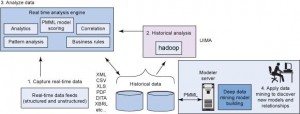IBM SPSS Predictive Analytics: An Overview
SPSS allows users in almost any industry to see into the future. The solution is part of IBM’s Business Analytics portfolio and works seamlessly with Cognos, the world’s flagship business intelligence reporting tool. Utilizing predictive analytics, SPSS connects data to effective action. SPSS draws on a powerful reserve of algorithms to analyze an organization’s existing data, as well as newly-captured data to enable smarter decisions and improve outcomes. When integrated with Cognos, different levels of users — from executives to analysts — can see game changing reports, scorecards, and other visuals on their desktops or mobile applications (as illustrated below).
This article will focus on some common uses of SPSS, a case study, and results.
Uses for SPSS
SPSS capabilities include reporting, scorecarding and dashboarding, forecasting and planning, predictive, social, and sentiment analysis, and decision management (as outlined below).
PLAN
- Assortment Management
- Sales & Operations Planning
- Resource planning
- Cost Forecasting
- Demand Forecasting
- Financial Forecasting
MANAGE
- Human Capital Management
- Claims Processing
- Inventory Management
- Disease Management
- Data Management
MAXIMIZE
- Pricing Optimization
- Predictive Management
- Program Evaluation & Effectiveness
- R&D Optimization
- Intelligent Logistics
- IBM SPSS aligns operational analytics to business processes and enables executives to plan for success, manage day-to-day operations, maximize operational performance, and maintain a strategic competitive advantage.
Using SPSS to Detect Threat and Fraud
Threat and fraud are mission-critical concerns for government, healthcare, and financial services, particularly banking and insurance. Today, new regulations and expectations around risk are propelling Governance Risk Compliance (GRC). The management of threat and fraud has accelerated in importance for executives. With SPSS, organizations can monitor the environment, detect suspicious activity, control outcomes, and develop policies and processes for effective enterprise governance.
The first operational step is to determine what is “normal” or in other words, to establish a baseline. The second step is to build a profile based upon a series of similar characteristics for acceptance and anomalies. There is a need to take the human factors out of the equation in the initial steps, allowing the speed of automation to span broad sections of data. Smart decision makers want to be certain, rather than guessing or relying on human analysis.
Solutions Overview: Capture > Predict > Act
Today, SPSS is a family of solutions that operates on Windows, zLinux, Linux/UNIX and Mac operating systems. The graphical user interface runs on Java, providing statistical analysis, data mining, text analysis, data collection, collaboration, and deployment. The SPSS family of solutions is comprised of four focus areas:
- SPSS Data Collection Capture attitudes, opinions and preferences for increasing CRM and increase client intimacy.
- SPSS Statistics Easily analyze any task, boost enterprise productivity and collaboration through server- based scalability.
- SPSS Modeling Gain new insights through modeling data from all types within a single intuitive visual interface to build trustworthy structures.
- SPSS Deployment:
– SPSS Decision Management Automate and optimize transactional decisions before deployment to consistently maximize outcomes. It combines predictive analytics, local rules and scoring to deliver recommended actions in real time.
– Deployment Services Integrate analytical results into enterprise operations to improve business processes, predict outcomes and deliver results to decision makers across the entire organization.
Case Study
Leading Global Car Manufacturer
Challenge
– Repeat warranty repairs at dealerships.
– Warranty costs were skyrocketing.
– Needed to analyze large amount of data (i.e. every car was a database).
Solution
– Use predictive analytics to analyze warranty issues and determine root cause.
– Automated analysis of structure dependencies, and relevancy of stored failure data.
Benefits
– Reduced warranty cases from 1.1 to 0.85 per vehicle.
– 5% reduction in warranty cases.
– Proactive identification of systematic errors.
Awareness
– Discover non-obvious customer segments.
– Identify customers likely to churn/defect.
– Determine product affinities.
Typical SPSS Deployment Results:
Tennessee Police Department
– Reduced crime by 30% and violent crime by 15%.
– Increased conviction rates four fold from 16% to 70%.
– Realized 863% ROI.
Medical Analytical Company
– Enabled hospitals to measure and predict patient payment behavior.
– Reduced risks from bad debt by $50M.
Auto Property and Casualty Insurance
– Discovered suspicious activity in real time.
– Reduced time to refer suspicious claims for investigation from 14 days to under 24hrs.
– Achieved an ROI of 403% (payback in 3 months).
– Doubled the accuracy of fraudulent claim identification.



